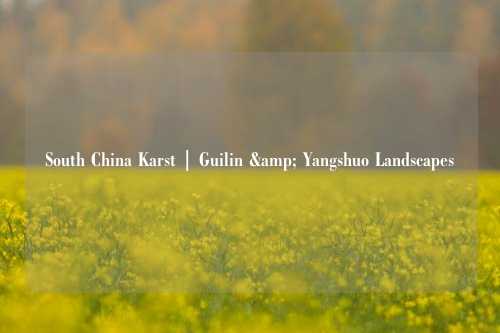South China Karst | Guilin & Yangshuo Landscapes
The South China Karst region, particularly the landscapes surrounding Guilin and Yangshuo in Guangxi Province, is one of the most awe-inspiring natural wonders in China and globally recognized for its remarkable topography. This region, renowned for its towering limestone peaks, serene rivers, and vibrant countryside, attracts travelers and nature lovers from all over the world. It is a place where the landscape seems to have been shaped by nature’s hand into surreal formations, creating a setting that has captured the imagination of poets, painters, and adventurers alike for centuries.
A Geologic Masterpiece
The Karst landscape of South China, including the famous areas of Guilin and Yangshuo, is a geological marvel. The region’s distinctive limestone formations, which have been sculpted over millions of years, create a strikingly unique visual appeal. These peaks, often referred to as “karst towers,” rise sharply from the surrounding plains, their jagged spires often veiled in mist, giving the area a mystical atmosphere. The landscape is the result of extensive erosion processes, where water, wind, and time have carved out a collection of caves, towers, and valleys, making it one of the most breathtaking and photographed locations in the world.

One of the defining features of the karst landscape is the way the peaks and formations appear to be in a constant state of flux, with the changing light of day shifting their shapes and contours. Early mornings and evenings, especially when the mist rises, offer visitors a chance to witness the beauty of the landscape in a way that seems almost otherworldly. The rivers that snake through the region, most notably the Li River, meander around the base of these peaks, adding another layer of charm to the area. The interplay of water and rock creates a dynamic and ever-changing landscape, with reflections of the karst towers visible in the calm river waters.
The Li River Cruise
One of the most popular and scenic ways to experience the South China Karst is by taking a boat cruise along the Li River. The Li River is famous for its smooth, winding course and the surrounding limestone peaks that rise dramatically on either side. The cruise offers an unparalleled perspective of the karst formations, with the peaks appearing almost as if they are rising directly from the water’s edge. This journey is often described as one of the most beautiful river cruises in the world.
The Li River, which stretches from Guilin to Yangshuo, passes through lush countryside and picturesque villages, providing a glimpse into rural life in the region. The riverbanks are lined with green fields, bamboo groves, and traditional wooden houses, further enhancing the sense of serenity and tranquility that defines the region. As the boat meanders through this captivating landscape, passengers are treated to views of the dramatic karst peaks, each one more captivating than the last. The towering peaks are often named after animals, objects, or figures from Chinese mythology, such as Elephant Trunk Hill, which resembles an elephant drinking from the river.
The Li River cruise is not only a visual treat but also an opportunity to connect with the natural beauty and cultural heritage of the area. The waterway has played an important role in the local culture for centuries, serving as a primary route for transportation and trade. Today, the Li River continues to be a vital part of the region’s economy, and a trip down its waters is an unforgettable experience for visitors seeking to immerse themselves in the area’s natural splendor.
Yangshuo: A Picturesque Village Amidst the Peaks
Yangshuo, located about 65 kilometers south of Guilin, is a charming town that serves as the gateway to the stunning karst landscapes. The town itself is situated between towering limestone peaks and is known for its breathtaking natural scenery, as well as its lively atmosphere. Yangshuo has long been a haven for artists, backpackers, and travelers seeking to experience the beauty of rural China.
In addition to its scenic surroundings, Yangshuo is a hub for outdoor activities. The surrounding landscape offers numerous opportunities for adventure, including hiking, rock climbing, cycling, and bamboo rafting. The countryside around Yangshuo is filled with winding paths that lead visitors through rice paddies, limestone hills, and quaint villages. Cycling is particularly popular in this area, as visitors can easily rent bikes and explore the rural landscape at their own pace. The “Yulong River Scenic Area” is one of the most popular cycling routes, where travelers can pedal along the riverbanks, surrounded by dramatic karst formations and traditional village life.
In addition to its natural beauty, Yangshuo is known for its vibrant local culture. The town hosts a variety of festivals throughout the year, celebrating traditional Chinese customs and arts. The “Impression Liu Sanjie” is a popular outdoor performance in Yangshuo, staged against the stunning backdrop of the karst mountains. The performance, directed by the famous Chinese filmmaker Zhang Yimou, is a multimedia spectacle that showcases local culture, music, and dance, set amidst the dramatic limestone peaks.
Yangshuo is also home to a thriving arts community, with numerous galleries and workshops where visitors can try their hand at traditional Chinese painting, calligraphy, and crafts. The town has become a gathering place for both local and international artists, who are drawn to the region’s natural beauty and unique atmosphere. The blend of local culture and international influences creates a dynamic and creative environment that adds to the charm of the area.
Guilin: The Gateway to the Karst Mountains
Guilin, often considered the starting point for visitors exploring the South China Karst region, is a bustling city that serves as the gateway to this geological wonderland. The city is situated along the Li River, with stunning views of the surrounding karst peaks visible from many parts of the city. Guilin has a long history and is one of China’s most famous tourist destinations, known for its beautiful landscapes, historic sites, and cultural significance.
One of the highlights of Guilin is Elephant Trunk Hill, a natural rock formation that resembles the trunk of an elephant drinking from the Li River. This iconic site is one of the most photographed landmarks in the region and offers visitors an opportunity to explore the scenic surroundings, including caves, pavilions, and temples. Another must-visit site in Guilin is Reed Flute Cave, a stunning limestone cave filled with colorful stalactites and stalagmites. The cave’s otherworldly formations are illuminated by vibrant lighting, creating a surreal and captivating atmosphere.
Guilin also boasts several parks and gardens, such as Seven Star Park, which is home to a collection of beautiful gardens, temples, and grottoes. Visitors can explore the park’s many trails, admire the views from the top of the hills, or relax by the lakes that are dotted throughout the area. The park’s Seven Star Cave, which is filled with ancient carvings and rock formations, is a particular highlight for those interested in the history and culture of the region.
Guilin is also an excellent base for exploring the surrounding countryside, which is home to several ethnic minority groups, including the Zhuang and Yao peoples. These groups have lived in the region for centuries and continue to maintain their traditional lifestyles. Visitors can take day trips to nearby villages to learn about local customs, sample traditional food, and experience the region’s cultural heritage.
The South China Karst: A UNESCO World Heritage Site
In 2007, the South China Karst was designated as a UNESCO World Heritage Site, recognizing the region’s outstanding universal value as a natural wonder. The site is one of the largest and most significant karst landscapes in the world, with its unique limestone formations and rich biodiversity. The karst region is home to a wide range of plant and animal species, many of which are endemic to the area, making it a haven for biodiversity conservation.
The designation as a UNESCO World Heritage Site has helped to raise awareness of the importance of preserving the South China Karst’s natural beauty and ecological integrity. Efforts have been made to ensure sustainable tourism practices in the region, with regulations in place to protect the delicate ecosystems and preserve the unique geological features of the landscape.
The South China Karst, with its stunning natural beauty, rich cultural heritage, and diverse wildlife, remains one of the most captivating and awe-inspiring landscapes in the world. Whether taking a cruise along the Li River, exploring the countryside by bike, or simply soaking in the views of the karst peaks, visitors to Guilin and Yangshuo are sure to be enchanted by this extraordinary region.
















